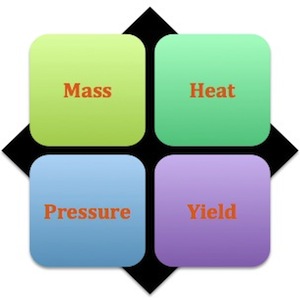RL Blogs

By Ralph Laurel
Jan 28, 2018Cat Cracking process monitoring is more than just trending the riser temperature. Improving Cat Cracking process monitoring involves understanding and improving the mass, heat, pressure, and yield balances for your Cat Cracker. |
||
| Cat Cracking process monitoring is a tremendous challenge for all involved. Refinerlink’s previous blogs on process monitoring are a good start. A deep understanding of all the delicate balances in a Cat Cracker can help improve the overall Cat Cracking process monitoring.
Cat Cracking process monitoring fundamentals can separate the mediocre engineer and refinery from the truly outstanding. This isn’t a specific guide to building a Cat Cracker process monitoring package, but it’s intended to give some insights on areas to address and ways to improve the typical Cat Cracking process engineering package.
It may be obvious to some that the hydrocarbon mass balance is important to Cat Cracking process monitoring. Without hydrocarbon mass balances it’s nearly impossible to troubleshoot any portion of a Cat Cracker unit.
But the equally important portion of the mass balance in a Cat Cracking process monitoring package is the catalyst mass balance. Can you account for every pound of catalyst from injection to regenerator spent catalyst to slurry catalyst content? Performance and accounting of all the Cat Cracking catalyst can aid troubleshooting efforts and improve the value of a Cat Cracker.
Heat Balance in Cat Cracker process monitoring is what separates the first and second quartile Cat Cracker. Heat balance is so important in a Cat Cracker, because of the chemical and thermal nature of a Cat Cracker. Do you understand the heat balance between the regenerator and reactor in the Cat Cracker? If you don’t how can you control and improve reactor yields. Do you understand the heat balance on the fractionation column and downstream recovery units?
Cat Cracking processing monitoring Heat Balance is not only important for the kinetic reactions of the plant, but also the distillation and heat recover/integration in the unit. Heat exchanger process monitoring without a Heat and Mass balance is almost impossible to do correctly.
The third “B” in Cat Cracking process monitoring is something that makes Cat Cracking so unique. Pressure Balance in Cat Cracking isn’t necessarily something that drives yield improvements. But is something that will drive reliability and long-term safe operation. The unique aspect of the air blower, regenerator, reactor, and wet gas compressor in a refinery process unit means that understanding the pressure profiles in every portion of the Cat Cracker can help improve overall performance and reliability. Pressure balances can also help trouble shoot issues with the mechanical aspects of the Cat Cracker such as the air grids or cyclones.
Finally, a Yield Balance in a Cat Cracking process monitoring package is what drives the economic heart of Cat Cracking process monitoring package. “Balance” is used loosely in mathematical sense here. Balance in this context is more focused on understanding the economic implications of a Cat Cracking in process monitoring.
Do you know how catalyst cost/usage impacts the operating expense of the Cat Cracker? Are you tracking the impact of feed quality variations on yields? Sometimes simple questions like these can focus the process monitoring to key economics indicators of the refinery.
In the context of Yield Balance working with the refinery economics group can help reinforce that daily yields targets are optimizing refinery economics especially in a world when the penalty for LPG in fuel gas, poor alkylation, or the depositions between gasoline and distillates can be so important.
RefinerLink’s goal is to improve refinery optimization, operations, and economics every day. Don’t lose sight of the basics and keep your focus on the “Four B’s” to help your refinery improve Cat Cracking process monitoring. Take your Cat Cracking process monitoring beyond time on the X-axis! | ||
|
|








